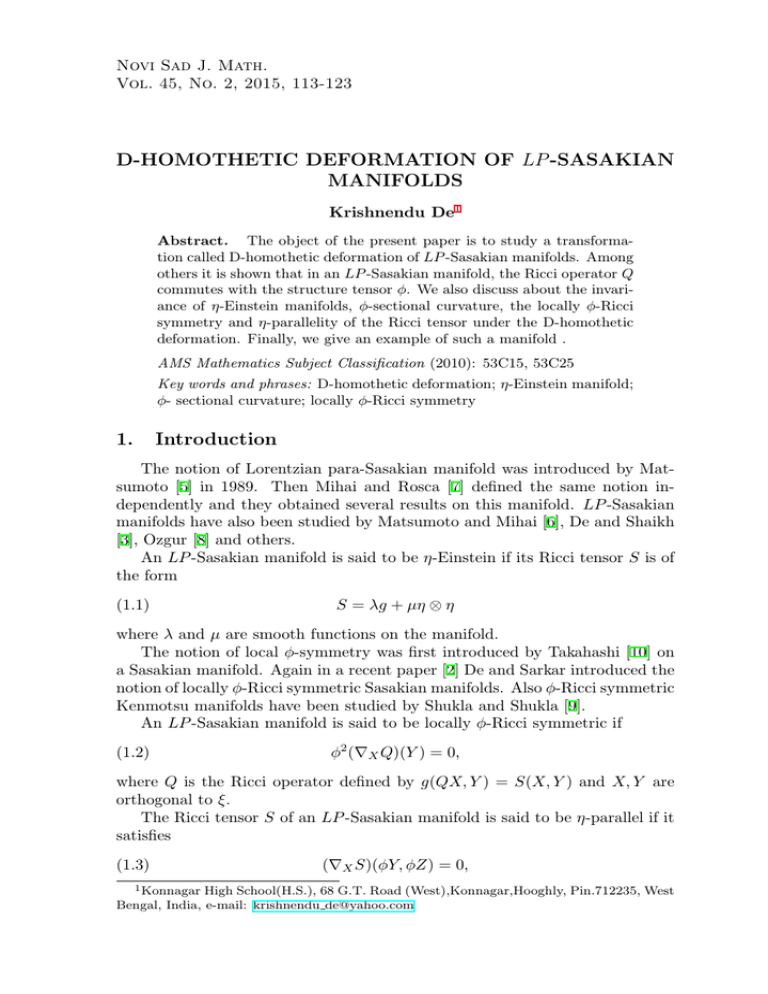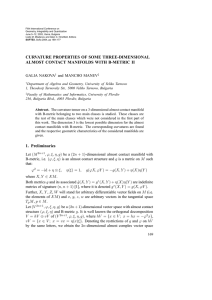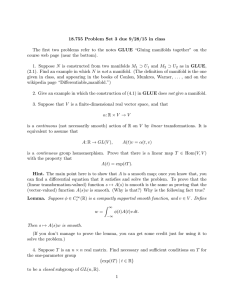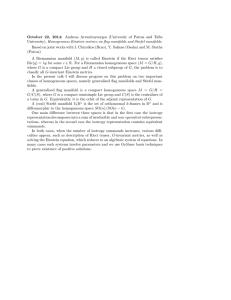D-HOMOTHETIC DEFORMATION OF MANIFOLDS Novi Sad J. Math.
advertisement

Novi Sad J. Math.
Vol. 45, No. 2, 2015, 113-123
D-HOMOTHETIC DEFORMATION OF LP -SASAKIAN
MANIFOLDS
Krishnendu De1
Abstract. The object of the present paper is to study a transformation called D-homothetic deformation of LP -Sasakian manifolds. Among
others it is shown that in an LP -Sasakian manifold, the Ricci operator Q
commutes with the structure tensor ϕ. We also discuss about the invariance of η-Einstein manifolds, ϕ-sectional curvature, the locally ϕ-Ricci
symmetry and η-parallelity of the Ricci tensor under the D-homothetic
deformation. Finally, we give an example of such a manifold .
AMS Mathematics Subject Classification (2010): 53C15, 53C25
Key words and phrases: D-homothetic deformation; η-Einstein manifold;
ϕ- sectional curvature; locally ϕ-Ricci symmetry
1.
Introduction
The notion of Lorentzian para-Sasakian manifold was introduced by Matsumoto [5] in 1989. Then Mihai and Rosca [7] defined the same notion independently and they obtained several results on this manifold. LP -Sasakian
manifolds have also been studied by Matsumoto and Mihai [6], De and Shaikh
[3], Ozgur [8] and others.
An LP -Sasakian manifold is said to be η-Einstein if its Ricci tensor S is of
the form
(1.1)
S = λg + µη ⊗ η
where λ and µ are smooth functions on the manifold.
The notion of local ϕ-symmetry was first introduced by Takahashi [10] on
a Sasakian manifold. Again in a recent paper [2] De and Sarkar introduced the
notion of locally ϕ-Ricci symmetric Sasakian manifolds. Also ϕ-Ricci symmetric
Kenmotsu manifolds have been studied by Shukla and Shukla [9].
An LP -Sasakian manifold is said to be locally ϕ-Ricci symmetric if
(1.2)
ϕ2 (∇X Q)(Y ) = 0,
where Q is the Ricci operator defined by g(QX, Y ) = S(X, Y ) and X, Y are
orthogonal to ξ.
The Ricci tensor S of an LP -Sasakian manifold is said to be η-parallel if it
satisfies
(1.3)
(∇X S)(ϕY, ϕZ) = 0,
1 Konnagar High School(H.S.), 68 G.T. Road (West),Konnagar,Hooghly, Pin.712235, West
Bengal, India, e-mail: krishnendu de@yahoo.com
114
Krishnendu De
for all vector fields X, Y and Z. The notion of η- parallelity in a Sasakian
manifold was introduced by Kon [4].
Let M (ϕ, ξ, η, g) be an almost contact metric manifold with dim M = m =
2n + 1. The equation η = 0 defines an (m − 1)-dimensional distribution D on
M [11]. By an (m − 1)-homothetic deformation or D-homothetic deformation
[12] we mean a change of structure tensors of the form
η̄ = aη,
1
ξ¯ = ξ,
a
ϕ̄ = ϕ,
ḡ = ag + a(a − 1)η ⊗ η,
where a is a positive constant. If M (ϕ, ξ, η, g) is an almost contact metric
¯ η̄, ḡ) is also an almost contact
structure with contact form η, then M (ϕ̄, ξ,
i
metric structure [12]. Denoting by Wjk the difference Γ̄ijk − Γijk of Christoffel
symbols we have in an almost contact metric manifold [12]
W (X, Y )
(1.4)
=
(1 − a)[η(Y )ϕX + η(X)ϕY ]
1
1
+ (1 − )[(∇X η)(Y ) + (∇Y η)(X)]ξ
2
a
for all X, Y ∈ χ(M ). If R and R̄ denote respectively the curvature tensor of
¯ η̄, ḡ), then we have [12]
the manifold M (ϕ, ξ, η, g) and M (ϕ̄, ξ,
R̄(X, Y )Z
(1.5)
= R(X, Y )Z + (∇X W )(Z, Y ) − (∇Y W )(Z, X)
+W (W (Z, Y ), X) − W (W (Z, X), Y )
for all X, Y, Z ∈ χ(M ).
A plane section in the tangent space Tp (M ) is called a ϕ-section if there
exists a unit vector X in Tp (M ) orthogonal to ξ such that {X, ϕX} is an
orthonormal basis of the plane section. Then the sectional curvature
K(X, ϕX) = g(R(X, ϕX)X, ϕX)
is called a ϕ-sectional curvature. A para contact metric manifold M (ϕ, ξ, η, g) is
said to be of constant ϕ-sectional curvature if at any point p ∈ M , the sectional
curvature K(X, ϕX) is independent of the choice of non-zero X ∈ Dp , where
D denotes the contact distribution of the para contact metric manifold defined
by η = 0.
The present paper is organized as follows:
After preliminaries in section 2, we prove some important lemmas. Section 4 deals with the study of (2n + 1)-dimensional η−Einstein LP -Sasakian
manifolds and prove that these manifolds are invariant under a D-homothetic
deformation. Also we study ϕ-sectional curvature, locally ϕ-Ricci symmetry
and η-parallelity of the Ricci tensor in a (2n + 1)-dimensional LP -Sasakian
manifold under a D-homothetic deformation. Finally in section 5, we cited an
example of LP -Sasakian manifold which validates a theorem of section 4.
D-Homothetic deformation of LP -Sasakian manifolds
2.
115
Preliminaries
Let M 2n+1 be an 2n + 1-dimensional differentiable manifold endowed with
a (1, 1) tensor field ϕ, a contravariant vector field ξ, a covariant vector field η
and a Lorentzian metric g of type (0, 2) such that for each point p ∈ M , the
tensor gp : Tp M × Tp M → R is a non-degenerate inner product of signature
(−, +, +, ....., +), where Tp M denotes the tangent space of M at p and R is the
real number space which satisfies
(2.1)
ϕ2 (X) = X + η(X)ξ, η(ξ) = −1,
(2.2)
g(X, ξ) = η(X), g(ϕX, ϕY ) = g(X, Y ) + η(X)η(Y )
for all vector fields X, Y . Then such a structure (ϕ, ξ, η, g) is termed as
Lorentzian almost paracontact structure and the manifold M 2n+1 with the
structure (ϕ, ξ, η, g) is called Lorentzian almost paracontact manifold [5]. In
the Lorentzian almost paracontact manifold M 2n+1 , the following relations
hold [5] :
(2.3)
ϕξ = 0, η(ϕX) = 0,
(2.4)
Ω(X, Y ) = Ω(Y, X),
where Ω(X, Y ) = g(X, ϕY ).
Let {ei } be an orthonormal basis such that e1 = ξ. Then the Ricci tensor
S and the scalar curvature r are defined by
S(X, Y ) =
n
∑
ϵi g(R(ei , X)Y, ei )
i=1
and
r=
n
∑
ϵi S(ei , ei ),
i=1
where we put ϵi = g(ei , ei ), that is, ϵ1 = −1, ϵ2 = · · · = ϵn = 1.
A Lorentzian almost paracontact manifold M n equipped with the structure
(ϕ, ξ, η, g) is called Lorentzian paracontact manifold if
Ω(X, Y ) =
1
{(∇X η)Y + (∇Y η)X}.
2
A Lorentzian almost paracontact manifold M n equipped with the structure
(ϕ, ξ, η, g) is called an LP -Sasakian manifold [5] if
(∇X ϕ)Y = g(ϕX, ϕY )ξ + η(Y )ϕ2 X.
116
Krishnendu De
In an LP -Sasakian manifold the 1-form η is closed. Also in [5], it is proved
that if an n- dimensional Lorentzian manifold (M n , g) admits a timelike unit
vector field ξ such that the 1-form η associated to ξ is closed and satisfies
(∇X ∇Y η)Z = g(X, Y )η(Z) + g(X, Z)η(Y ) + 2η(X)η(Y )η(Z),
then M n admits an LP -Sasakian structure.
Further, on such an LP -Sasakian manifold M n (ϕ, ξ, η, g), the following
relations hold [5]:
(2.5)
η(R(X, Y )Z) = [g(Y, Z)η(X) − g(X, Z)η(Y )],
(2.6)
S(X, ξ) = 2nη(X),
(2.7)
R(X, Y )ξ = [η(Y )X − η(X)Y ],
(2.8)
R(ξ, X)Y = g(X, Y )ξ − η(Y )X,
(2.9)
(∇X ϕ)(Y ) = [g(X, Y )ξ + 2η(X)η(Y )ξ + η(Y )X],
for all vector fields X, Y, Z, where R, S denote respectively the curvature
tensor and the Ricci tensor of the manifold. Also since the vector field η is
closed in an LP -Sasakian manifold, we have ([6],[5])
(2.10)
(∇X η)Y = Ω(X, Y ),
(2.11)
Ω(X, ξ) = 0,
(2.12)
∇X ξ = ϕX,
for any vector field X and Y.
3.
Some Lemmas
In this section we shall state and prove some Lemmas which will be needed
to prove the main results.
Lemma 3.1. [1] In an LP -Sasakian manifold, the following relation holds
g(R(ϕX, ϕY )ϕZ, ϕW )
(3.1)
=
g(R(X, Y )Z, W ) + g(X, W )η(Y )η(Z)
−g(X, Z)η(W )η(Y ) + g(Y, Z)η(X)η(W )
−g(Y, W )η(X)η(Z).
D-Homothetic deformation of LP -Sasakian manifolds
117
Lemma 3.2. Let (M 2n+1 , g) be an LP -Sasakian manifold. Then the Ricci
operator Q commutes with ϕ.
Proof. From (3.1), it follows that
= R(X, Y )Z − [η(Z)Y − g(Y, Z)ξ]η(X)
ϕR(ϕX, ϕY )ϕZ
+[Xη(Z) − g(X, Z)ξ]η(Y ).
(3.2)
Let {ei , ϕei , ξ}, i = 1, 2, ....., n be an orthonormal frame at any point of the
manifold. Then putting Y = Z = ei in (3.2) and taking summation over i and
using η(ei ) = 0 , we get
(3.3)
n
∑
ϵi ϕR(ϕX, ϕei )ϕei =
i=1
n
∑
ϵi R(X, ei )ei − nη(X)ξ,
i=1
where ϵi = g(ei , ei ).
Again setting Y = Z = ϕei in (3.2), taking summation over i and using
η.ϕ = 0, we get
(3.4)
n
∑
ϵi ϕR(ϕX, ei )ei =
i=1
n
∑
ϵi R(X, ϕei )ϕei − nη(X)ξ.
i=1
Adding (3.3) and (3.4) and using the definition of the Ricci tensor, we obtain
ϕ(QϕX − R(ϕX, ξ)ξ) = QX − R(X, ξ)ξ − 2nη(X)ξ.
Using (2.7) and ϕξ = 0 in the above relation, we have
ϕ(QϕX) = QX − 2nη(X)ξ.
Operating both sides by ϕ and using (2.1), symmetry of Q and ϕξ = 0, we
get ϕQ = Qϕ. This proves the lemma.
Proposition 3.1. In an 2n+1-dimensional η-Einstein LP -Sasakian manifold,
the Ricci tensor S is expressed as
S(X, Y )
(3.5)
=
r
− 1]g(X, Y )
2n
r
−[
− 2n − 1]η(X)η(Y ).
2n
[
118
Krishnendu De
4.
Main results
In this section we study η-Einstein LP -Sasakian manifolds, ϕ-sectional curvature, locally ϕ-Ricci symmetry and η-parallelity of the Ricci tensor of an odd
dimensional LP -Sasakian manifold under a D-homothetic deformation.
In virtue of (2.10), the relation (1.4) reduces to
(4.1)
1
W (X, Y ) = (1 − a)[η(Y )ϕX + η(X)ϕY ] + (1 − )g(ϕX, Y )ξ.
a
In view of (2.9), (2.10) and (2.12), the relation (4.1) yields
(∇Z W )(X, Y )
=
(1 − a)[{g(ϕZ, Y )ϕX
+g(X, Z)η(Y )ξ + 2η(X)η(Y )Z + 4η(X)η(Y )η(Z)ξ
+g(ϕZ, X)ϕY + η(X)g(Y, Z)ξ]
a−1
g(ϕX, Y )ϕZ.
+
a
(4.2)
Using (4.1) and (4.2) into (1.5), we obtain by virtue of (2.7) and (2.10) that
R̄(X, Y )Z
= R(X, Y )Z + (1 − a)[g(X, Z)η(Y )ξ
−g(Y, Z)η(X)ξ + 2η(Y )η(Z)X
−2η(X)η(Z)Y
+g(ϕX, Z)ϕY − g(ϕY, Z)ϕX]
a−1
+
[g(ϕZ, Y )ϕX − g(ϕZ, X)ϕY ]
a
+(1 − a)2 [η(X)η(Z)Y − η(Y )η(Z)X]
(1 − a)2
−
[g(ϕZ, X)ϕY − g(ϕZ, Y )ϕX]
a
(4.3)
Putting Y = Z = ξ in (4.3) and using (2.1) we obtain
(4.4)
R̄(X, ξ)ξ = R(X, ξ)ξ + 2(1 − a)[−X + η(X)ξ] − (1 − a)2 ϕ2 X.
Let {ei , ϕei , ξ}, i = 1, 2, ....., n be an orthonormal frame at any point of the
manifold. Then putting Y = Z = ei in (4.3) and taking summation over i and
using η(ei ) = 0, we get
(4.5)
n
∑
ϵi R̄(X, ei )ei =
i=1
n
∑
ϵi R(X, ei )ei − (1 − a)nη(X)ξ,
i=1
where ϵi = g(ei , ei ).
Again setting Y = Z = ϕei in (4.3) and taking summation over i and using
η.ϕ = 0, we get
(4.6)
n
∑
i=1
ϵi R̄(X, ϕei )ϕei =
n
∑
i=1
ϵi R(X, ϕei )ϕei − (1 − a)nη(X)ξ.
D-Homothetic deformation of LP -Sasakian manifolds
119
Adding (4.5) and (4.6) and using the definition of Ricci operator we have
(4.7)
Q̄X − R̄(X, ξ)ξ = QX − R(X, ξ)ξ − 2(1 − a)nη(X)ξ.
In view of (4.4) we get from (4.7)
S̄(X, Y ) =
S(X, Y ) − [2(1 − a) + (1 − a)2 ]g(X, Y )
−[2(1 − a)(n − 1) + (1 − a)2 ]η(X)η(Y ),
(4.8)
which implies that
Q̄X
(4.9)
= QX − [2(1 − a) + (1 − a)2 ]X
−[2(1 − a)(n − 1) + (1 − a)2 ]η(X)ξ.
Operating ϕ̄ = ϕ on both sides of (4.9) from the left we have
(4.10)
ϕ̄Q̄X = ϕQX − [2(1 − a) + (1 − a)2 ]ϕX.
Again, putting ϕ̄X = ϕX in (4.9) from the right we have
(4.11)
Q̄ϕ̄X = QϕX − [2(1 − a) + (1 − a)2 ]ϕX.
Subtracting (4.10) and (4.11) we get
(4.12)
(ϕ̄Q̄ − Q̄ϕ̄)X = (ϕQ − Qϕ)X.
Therefore using Lemma 3.2 we can state the following:
Theorem 4.1. Under a D-homothetic deformation, the expression Q̄ϕ̄ = ϕ̄Q̄
holds in an (2n + 1)-dimensional LP -Sasakian manifold.
4.1.
η-Einstein LP -Sasakian manifolds
Let M (ϕ, ξ, η, g) be a (2n+1)-dimensional η-Einstein LP -Sasakian manifold
¯ η̄, ḡ) under a D-homothetic deformation. Then from
which reduces to M (ϕ̄, ξ,
(4.8) it follows by virtue of (3.5)that
(4.13)
S̄(X, Y ) = λ̄ḡ(X, Y ) + µ̄η̄(X)η̄(Y ),
where λ̄, µ̄ are smooth functions given by
(4.14)
λ̄ = [
r
− (a − 2)2 ]
2n
and
(4.15)
µ̄ = [
r
− 4n + 2an − a2 ].
2n
In view of the relation (4.13) we state the following:
Theorem 4.2. Under a D-homothetic deformation, a (2n + 1)-dimensional
η-Einstein LP -Sasakian manifold is invariant.
120
4.2.
Krishnendu De
ϕ-sectional curvature of LP -Sasakian manifolds
In this section we consider the ϕ-sectional curvature on a (2n + 1)-dimensional LP -Sasakian manifold.
From (4.3) it can be easily seen that
(4.16)
K̄(X, ϕX) − K(X, ϕX) = −2(a − 1)
and hence we state the following theorem.
Theorem 4.3. The ϕ-sectional curvature of (2n+1)-dimensional LP-Sasakian
manifolds is not an invariant property under D-homothetic deformations.
¯ η̄, ḡ) satisfies
If a (2n + 1)-dimensional LP -Sasakian manifold M (ϕ̄, ξ,
R(X, Y )ξ = 0 for all X, Y , then it can be easily seen that K(X, ϕX) = 0
and hence from (4.16) it follows that
K̄(X, ϕX) = −2(a − 1) ̸= 0,
where X is a unit vector field orthogonal to ξ and K(X, ϕX) is the ϕ-sectional
curvature. This implies that the ϕ-sectional curvature K̄(X, ϕX) is non-vanishing. Therefore we state the following:
Theorem 4.4. There exists (2n + 1)-dimensional LP -Sasakian manifold with
non-zero ϕ-sectional curvature.
4.3.
Locally ϕ-Ricci symmetric LP -Sasakian manifolds
In this section we study locally ϕ-Ricci symmetry on an LP -Sasakian manifold.
Differentiating (4.9) covariantly with respect to W we obtain
(∇W Q̄)(X) =
(4.17)
(∇W Q)(X)
−[2(1 − a)(n − 1) + (1 − a)2 ](∇W η)(X)ξ
−[2(1 − a)(n − 1) + (1 − a)2 ]η(X)∇W ξ.
Operating ϕ2 on both sides of (4.17) and taking X as an orthonormal vector
to ξ we obtain
(4.18)
ϕ̄2 (∇W Q̄)(X) = ϕ2 (∇W Q)(X).
In view of the relation (4.18) we state the following:
Theorem 4.5. The local ϕ-Ricci symmetry on LP-Sasakian manifolds is an
invariant property under D-homothetic deformations.
D-Homothetic deformation of LP -Sasakian manifolds
4.4.
121
η− parallel Ricci tensor of an LP -Sasakian manifolds
Let us consider the η-parallelity of the Ricci tensor on an LP -Sasakian
manifold.
Differentiating (4.8) covariantly with respect to W and using (2.10) we
obtain
(∇W S̄)(X, Y )
(4.19)
=
(∇W S)(X, Y )
−[2(1 − a)(n − 1) + (1 − a)2 ]
[g(ϕW, X)η(Y ) + g(ϕW, Y )η(X)].
In (4.19) replacing X by ϕX, Y by ϕ Y and using (2.3) we get
(4.20)
(∇W S̄)(ϕX, ϕY ) = (∇W S)(ϕX, ϕY ).
Hence we can state the following:
Theorem 4.6. The η-parallelity of the Ricci tensor on LP-Sasakian manifolds
is an invariant property under D-homothetic deformations.
5.
Example
We consider the 3-dimensional manifold M = {(x, y, z) ∈ R3 }, where
(x, y, z) are standard coordinates of R3 .
The vector fields
e1 = ez
∂
∂
∂
∂
, e 2 = ez (
+
), e3 =
∂y
∂x ∂y
∂z
are linearly independent at each point of M.
Let g be the Lorentzian metric defined by
g(e1 , e3 ) = g(e1 , e2 ) = g(e2 , e3 ) = 0,
g(e1 , e1 ) = g(e2 , e2 ) = 1,
g(e3 , e3 ) = −1.
Let η be the 1-form defined by η(Z) = g(Z, e3 ) for any Z ∈ χ(M ).
Let ϕ be the (1, 1) tensor field defined by
ϕ(e1 ) = −e1 , ϕ(e2 ) = −e2 , ϕ(e3 ) = 0.
Then using the linearity of ϕ and g, we have
η(e3 ) = −1,
ϕ2 Z = Z + η(Z)e3 ,
g(ϕZ, ϕW ) = g(Z, W ) + η(Z)η(W ),
for any Z, W ∈ χ(M ).
122
Krishnendu De
Then for e3 = ξ , the structure (ϕ, ξ, η, g) defines a Lorentzian paracontact
structure on M .
Let ∇ be the Levi-Civita connection with respect to the Lorentzian metric
g and let R be the curvature tensor of g. Then we have
[e1 , e3 ] = −e1
[e1 , e2 ] = 0,
and [e2 , e3 ] = −e2 .
Taking e3 = ξ and using Koszul’s formula for the Lorentzian metric g, we
can easily calculate
∇e1 e3 = −e1 ,
∇e1 e2 = 0,
∇e2 e3 = −e2 ,
∇e2 e2 = −e3 ,
∇e3 e3 = 0,
(5.1)
∇e3 e2 = 0,
∇e1 e1 = −e3 ,
∇e2 e1 = 0,
∇e3 e1 = 0.
From the above it can be easily seen that M 3 (ϕ, ξ, η, g) is an LP -Sasakian
manifold. With the help of the above results it can be easily verified that
R(e2 , e3 )e3 = −e2 ,
R(e1 , e2 )e3 = 0,
R(e1 , e3 )e3 = −e1 ,
R(e1 , e2 )e2 = e1 ,
R(e2 , e3 )e2 = −e3 ,
R(e1 , e3 )e2 = 0,
R(e1 , e2 )e1 = −e2 ,
R(e2 , e3 )e1 = 0,
R(e1 , e3 )e1 = −e3 .
From the above expressions of the curvature tensor we obtain
= g(R(e1 , e2 )e2 , e1 ) − g(R(e1 , e3 )e3 , e1 )
= 2.
S(e1 , e1 )
Similarly we have
S(e2 , e2 ) = 2
and
S(e3 , e3 ) = −2.
Therefore,
r = S(e1 , e1 ) + S(e2 , e2 ) − S(e3 , e3 ) = 6.
From [3] we know that in a 3- dimensional LP -Sasakian manifold
R(X, Y )Z
r−4
r−6
)[g(Y, Z)X − g(X, Z)Y ] + (
)[g(Y, Z)η(X)ξ
2
2
−g(X, Z)η(Y )ξ + η(Y )η(Z)X − η(X)η(Z)Y ].
= (
(5.2)
Now using (5.2) we get
g(R(X, Y )Z, W )
(5.3)
=
r−4
)[g(Y, Z)g(X, W ) − g(X, Z)g(Y, W )]
2
r−6
+(
)[g(Y, Z)η(X)η(W ) − g(X, Z)η(Y )η(W )
2
+η(Y )η(Z)g(X, W ) − η(X)η(Z)g(Y, W )].
(
D-Homothetic deformation of LP -Sasakian manifolds
123
From (5.3), it follows that the ϕ- sectional curvature of the manifold is given
by
K(X, ϕX) =
r−4
2
for any vector field X orthogonal to ξ.
In view of the above relation we get
K(e1 , ϕe1 ) = K(e2 , ϕe2 ) =
r−4
2
Again it can be easily shown from (4.3) that
K̄(e1 , ϕe1 ) − K(e1 , ϕe1 ) = −2(a − 1)
and
K̄(e2 , ϕe2 ) − K(e2 , ϕe2 ) = −2(a − 1)
Therefore Theorem 4.3 is verified.
References
[1] Al-Aqeel, A., De, U.C., Ghosh, G.C., On Lorentzian para- Sasakian manifolds.
Kuwait J. Sci. Eng. 31 (2004), 1-13.
[2] De, U.C., Sarkar, A., On ϕ−Ricci symmetric Sasakian manifolds. Proceedings
of the Jangjeon Mathematical Society 11(1) (2008), 47-52.
[3] De, U.C., Shaikh, A.A., On 3- dimensional LP -Sasakian manifolds. Soochow J.
Math. 26 (2000), 359-368.
[4] Kon, M., Invariant submanifolds in Sasakian manifolds. Math. Ann. 219 (1976),
277-290.
[5] Matsumoto, K., On Lorentzian paracontact manifolds. Bull. Yamagata Univ.
Natur. Sci. 12 (1989), 151-156.
[6] Matsumoto, K., Mihai, I., On a certain transformation in a Lorentzian ParaSasakian Manifold. Tensor (N.S.) 47 (1988), 189-197.
[7] Mihai, I., Rosca, R., On Lorentzian P-Sasakian Manifolds. Classical Analysis.
World Scientific, Singapore (1992), 155-169.
[8] Ozgur, C., ϕ-conformally flat Lorentzian Para-Sasakian Manifolds. Radovi
Matematički 12 (2003), 99-106.
[9] Shukla, S.S., Shukla, M.K., On ϕ-Ricci symmetric Kenmotsu manifolds. Novi
Sad J. Math. 39(2) (2009), 89-95.
[10] Takahashi, T., Sasakian ϕ−symmetric spaces. Tohoku Math. J. 29 (1977), 91113.
[11] Tanno, S., Partially conformal transformations with respect to (m − 1)-dimensional distribution of m-dimensional Riemannian manifolds. J. Tohoku Math.
2(17) (1965), 358-409.
[12] Tanno, S., The topology of contact Riemannian manifolds. J. Tohoku Math. 12
(1968), 700-717.
Received by the editors July 1, 2014





